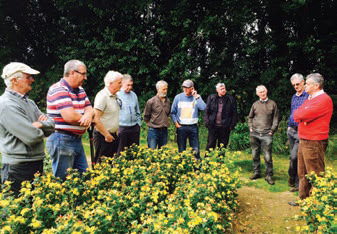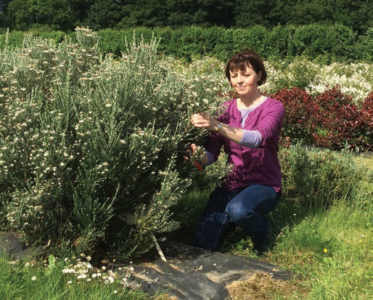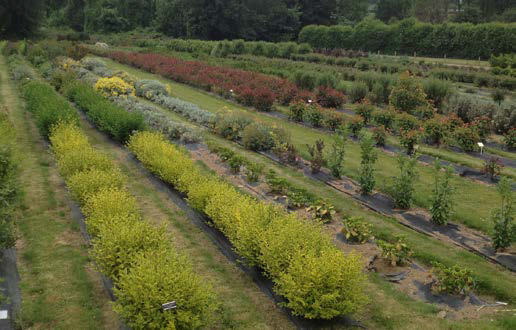Dr. Andy Whelton presents an overview of how Ireland’s cut foliage sector is expanding to meet a rising global market
Cut foliage production is an innovative market led sector of Irish horticulture. It describes
the decorative greenery used in floristry and is obtained from a wide variety of trees, shrubs and herbaceous perennial plants. Worldwide demand in developed countries is increasing and prospects for continuing expansion of the small Irish industry for export markets are very good. Ironically at a time when there is an overproduction of many farm commodities, the demand for high quality, well graded cut foliage to export markets is buoyant.
The European flower industry is worth €2.5bn with the foliage element estimated at 10% of this or €250m. The UK and Dutch packers and distributors need high volume supplies, and peak periods such as Christmas and Valentine’s Day are seeing significant increases in demand for cut foliage year on year. Indications are that the market is growing at 10% per annum.
25 growers are currently exporting over €5m worth of greenery, providing much-needed employment in harvest and processing in rural counties of Kerry, Cork, Wexford and Waterford. The mild, relatively frost-free climate in Southern Ireland is ideal for growing lush, premium foliage. A plentiful supply of water, rich organic soils and the short distance to market are all major advantages over competitors from Israel, Italy and developing countries. 70% of Irish foliage currently ends up in UK multiples such as Morrisons, ASDA and the horticultural suppliers to M&S, Waitrose, Tesco and Sainsburys.
IMPORTANCE OF APPLIED RESEARCH
Effective technical and research support is proving vital to the development and success of the relatively new cut foliage business. Evaluation of species, providing fully costed production and management blueprints for core and new species forms the basis of much of the current work programme.
There is a continuous need for a stream of new material that is market led as buyers and customers are constantly looking for innovation with new products displaying different textures, colours and scents in a discerning and competitive market. For that reason, in 2011 with support from Bord Bia, an extensive collection of over 100 species of foliage plant material from different parts of the world was established at Kildalton College, the
aim being to screen suitability from a climatic and marketing point of view. This is ongoing work, with new material being added annually and a number of newer types are now beginning to emerge which are being expanded in the industry.
Given the exacting market requirements for the continuity of supply of quality cut foliage, developing production and management protocols for ornamental species play a large part of the ongoing research and applied extension work on growers holdings in Wexford, Kerry and Kildalton College. The delivery of uniform stems of suitable length and spray form can only be achieved when the optimum plant density coupled with the best management practices of pruning, nutrition and pest and disease control is met. The applied research work on foliage aims to meet these exacting requirements. More sustainable control measures fostering eco-friendly production, which is now desirable under the Sustainable Use and Integrated Crop Management directives, are an important aspect of the current
research programme in Teagasc. Irish foliage is well positioned to capitalise on the recent surge in environmental accreditation being demanded by the multiples, and Teagasc research on sustainable production systems is crucial to progressing the industry and meeting the high regulatory and market specifications. Dr. Michael Gaffney, a Teagasc entomologist, is leading a programme on pest monitoring and the development of trapping technologies that encourage growers to target pesticide application under sustainable production of foliage. Two of the most serious pests of ornamental foliage production – Carnation Tortrix and Capsid species – are being focused on in this work.

FOCUSED RESEARCH
WORK ON PRUNING
Most plant species flower at a particular stage in the season but trials work aimed at preventing the flowering phase and inducing vegetative growth is more desirable in cut foliage production. Techniques such as timed pruning and altering the nutrition levels on plant species are helping to deliver a product which is demanded in high volume at the key periods such as Christmas and Valentine’s Day.
A recently completed MSc by Kildalton College’s amenity technician, Catherine Gavin has helped in plugging information gaps in optimum pruning treatments of Ozothamnus, a key foliage species for the Christmas market. Pruning regimes on young and older material coupled with summer tip pruning to improve the shape of stems were closely examined in the research. The results indicated that higher yields of saleable stems are produced when Ozothamnus ‘Sussex Silver’ is pruned in March rather than in June, regardless of whether they are pruned to 200mm or 500mm. More vigorous rejuvenation resulting in higher yields of desirable length and quality was evident in younger pruned sites compared to older more established crops, suggesting an age of species to be an important factor to bear in mind. Summer tip pruning while improving the quality of spray stems is not recommended for this species, given the high labour cost involved.

College on which she carried out an M.Sc research thesis
on Pruning
CONTINUITY OF SUPPLY WITH PROTECTED CROPS
Kildalton’s horticulture principal, Grainne McMahon and I have undertaken trials on developing production protocols for the continuity of supply of foliage fillers including flower species, which aim to supply foliage and meet supermarket demand for the product in the offseason to complement the main production period. This provides Irish producers with a clear market advantage. Using protected structures for early and late season cropping, coupled with a range of varieties and pruning regimes, production blueprints have been developed for bouquet fillers; fillers – Solidago and ornamental brassicas – just two species developed to date and currently being scaled up by growers in the industry.

Flower crops such as herbaceous Paeony rose and scented stock are currently the focus of agronomy work which aims to provide the Irish industry with a suite of products demanded by a discerning developing market currently undersupplied both at home and in other EU countries.
DAFM Grant Aid
The Foliage Ireland group, which oversees development of the sector comprise Teagasc, DAFM, Bord Bia, and Enterprise Ireland. Processors and growers are keen to see orderly, professional development and expansion of the industry. With a target of €20m under-harvest in 2020, the Department of Agriculture provides support by way of grant aid for those interested in getting into the business. If location and soil type are deemed suitable by Teagasc, new entrants must be prepared to follow a strict protocol with regard to management and harvest, which has been developed for the key species. It can cost €5,000 to €12,000 per hectare to establish a plantation depending on the species and system of production and the returns can be in the region of €3,000 to €7,000 per annum from the third year onwards.
Future private and state investment in the development and commercialisation of innovative new species from trials in places like Kildalton will see the foliage industry copper-fasten its position as the dominant force for the mid to high-end marketplace.
Major challenges lie ahead for the industry. Success will depend on a high level of market coordination and production based on committed, professional growers with solid research and technical backup.
If you are interested in hearing more about the cut foliage enterprise or would like to visit the trial site at Teagasc Kildalton College you can do so by contacting Catherine Gavin on 051 644 422 or Andy Whelton on 087 784 8065. ✽
 Andy Whelton M Sc Ag Sc is a horticultural development officer in the Teagasc Horticultural Development Department based in Teagasc Clonakilty College and is specialist adviser on ornamental cut foliage. He has spearheaded the developments in cut foliage as a new sector in commercial horticulture. He also works closely with outdoor vegetable and protected crop businesses in Munster and south Leinster. You can contact Andy at andy.whelton@teagasc.ie Andy Whelton M Sc Ag Sc is a horticultural development officer in the Teagasc Horticultural Development Department based in Teagasc Clonakilty College and is specialist adviser on ornamental cut foliage. He has spearheaded the developments in cut foliage as a new sector in commercial horticulture. He also works closely with outdoor vegetable and protected crop businesses in Munster and south Leinster. You can contact Andy at andy.whelton@teagasc.ie |





